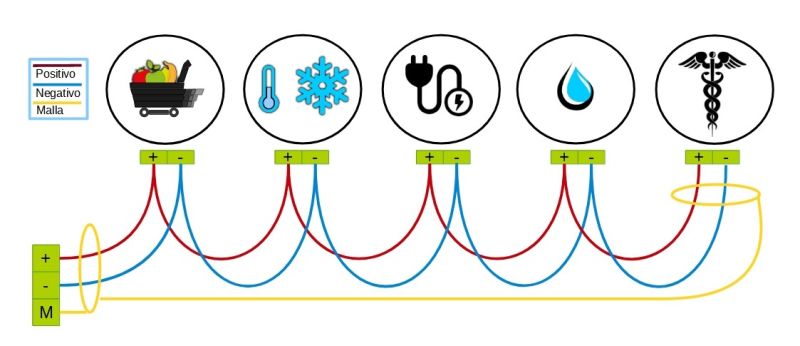Diferencia entre revisiones de «CheckWiring/en»
Página creada con «The polarities are those strictly used in the [https://{{SERVERNAME}}/index.php/Special:MyLanguage/Modbus-protocol#Protocolo_Modbus '''modbus protocol'''] RTU using the Daisy-chain typology described in the [https://{{SERVERNAME}}/index.php/Special:MyLanguage/ModbusRTU-RS485#Requisitos_de_cableado '''wiring requirements''']. File:SP - Esquema de un bus único siguiendo la topología daysi change.jpg|center|imagethumbnail|800x800px|Scheme of a single bus following th…» |
Página creada con «The polarities must be connected to each other using the terminal block of the kiconex panel or kiBox as the start or end of the line, never connecting to the monitored machines or deviced. If the mesh is connected to a machine, the voltage it may have may end up being induced in the communication bus creating electrical noise and conflicts on it, including breaking ports on the kiBox.» |
||
| Línea 29: | Línea 29: | ||
[[File:SP - Esquema de un bus único siguiendo la topología daysi change.jpg|center|imagethumbnail|800x800px|Scheme of a single bus following the daisy-chain topology]] | [[File:SP - Esquema de un bus único siguiendo la topología daysi change.jpg|center|imagethumbnail|800x800px|Scheme of a single bus following the daisy-chain topology]] | ||
The polarities must be connected to each other using the terminal block of the kiconex panel or kiBox as the start or end of the line, never connecting to the monitored machines or deviced. If the mesh is connected to a machine, the voltage it may have may end up being induced in the communication bus creating electrical noise and conflicts on it, including breaking ports on the kiBox. | |||
<div lang="es" dir="ltr" class="mw-content-ltr"> | <div lang="es" dir="ltr" class="mw-content-ltr"> | ||
Revisión del 09:16 23 may 2024
Checking the RTU-RS485 modbus wiring
Modbus RTU-RS485 wiring should be checked after start-up of the facility and when starting to visualize communication problems on the platform.
You can consult how to make the Modbus RTU-RS485 Connection by clicking on the {SERVERNAME}}/index.php/Special:MyLanguage/ModbusRTU-RS485 link.
If there are errors, with the help of the graphs, you can have a first visualization of these errors. It is possible that only points are displayed, intermittent cuts, false connections in the control (the control appears as connected even though it is not recording data), intermittent disconnections of the controls on the platform, loss of readings on one bus or several, among others.
Below are some graphs where these intermittent communication failures are identified.



Medición de los buses
Los puntos que se deben tener en cuenta para las comprobaciones son las siguientes:
Polarities
The polarities are those strictly used in the modbus protocol RTU using the Daisy-chain typology described in the wiring requirements.

The polarities must be connected to each other using the terminal block of the kiconex panel or kiBox as the start or end of the line, never connecting to the monitored machines or deviced. If the mesh is connected to a machine, the voltage it may have may end up being induced in the communication bus creating electrical noise and conflicts on it, including breaking ports on the kiBox.
Voltaje
Se debe medir tensiones en corriente alterna y corriente continua con ayuda de un multímetro.
Las mediciones se deben realizar directamente en el bus por lo que se debe DESCONECTAR obligatoriamente el bus completo (positivo, negativo y malla) del bornero o del kiBox en caso de no tener cuadro.
Se debe medir entre positivo-negativo, positivo-malla y negativo-malla, tanto en alterna como en continua.
NO DEBE TENER TENSIÓN ALGUNA EN ALTERNA.
En continua puede tener posiblemente hasta 1 Vcc debido al flujo de comunicación.
En caso de tener corriente alterna se debe identificar el equipo que está induciendo esta tensión en el bus y revisar el cableado que esté en condiciones óptimas.
La siguiente tabla puede facilitar la recopilación de datos sobre las mediciones:
Continuidad
Se debe medir continuidad entre positivo-negativo, positivo-malla y negativo-malla, siendo esta INEXISTENTE.
En caso de tener continuidad, se debe identificar el contacto que está provocando esta continuidad y subsanar la incidencia.
A tener en cuenta
El bus de comunicación debe estar alejado del cableado de fuerza ya que esto puede producir ruido, se debe tener en cuenta también las conexiones dentro de su equipo monitorizado.
El bus con tensión NO se debe conectar al bornero del cuadro o al kiBox, esta acción puede derivar en avería del kiBox. En caso de que se realice una sustitución se deben comprobar los buses antes de conectarlos.
Una vez saneados los buses y aisladas las máquinas problemáticas tendrá una visualización correcta de las lecturas de los equipos monitorizados sobre la plataforma.



